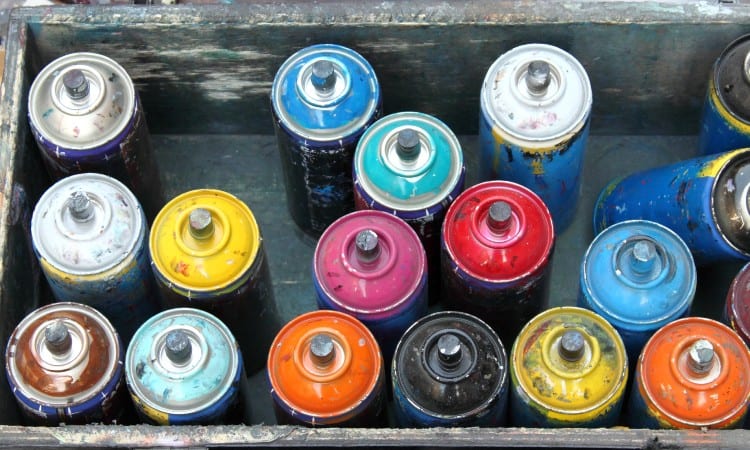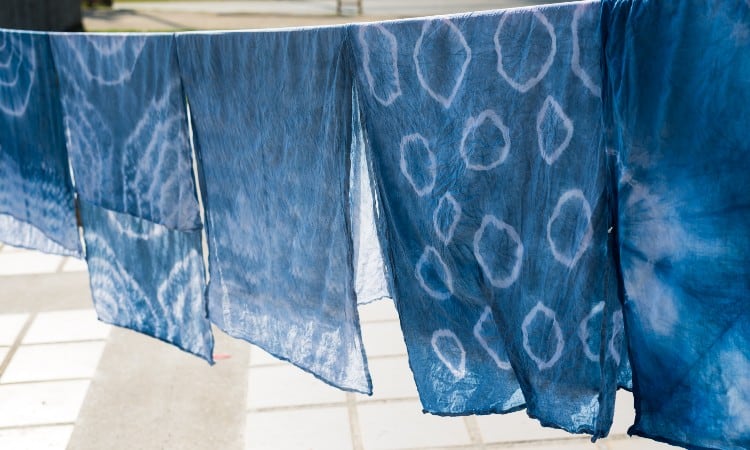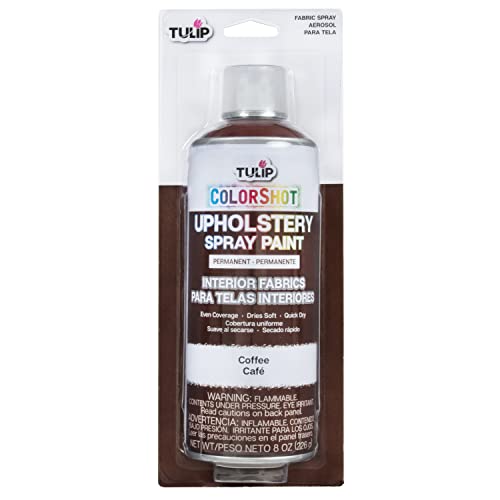Painting fabric is becoming a popular trend. A fresh touch of paint can rejuvenate your home décor and clothing. Spray painting in particular is quick, easy, and fun to do. But can you combine the two? Can you spray paint fabric?
You can add color to fabric using several types of spray paint designed for textiles. The technique can create decorative and colorful effects. Not all spray paints are suitable for fabric, though. You must make sure the paint is non-toxic and compatible with the fabric.
Knowing it’s possible to spray paint fabric is one thing. The next problem, where do you start? How do you know what you can paint and which spray paint you can use? In this article, we’ll answer those questions and more.

Quick Navigation
- Can You Spray Paint Fabric?
- Can You Spray Paint Clothes?
- Can Curtains Be Spray Painted?
- What Fabrics Can Be Spray Painted?
- How to Spray Paint Fabrics
- How to Spray Paint Clothing
- How to Paint Upholstery
- Can You Use Regular Spray Paint on Fabric?
- Best Spray Paint for Fabric
- Does Spray Paint Wash off Clothes?
- How Do You Care for Spray Painted Fabrics?
- Conclusion
Can You Spray Paint Fabric?
With so many fabrics available in so many different colors, you may be wondering why anyone would want to spray paint fabric.
Color options change over time. There are always new, vibrant colors and combinations hitting the market. So much so, what may have been on trend only a year ago, will probably be aging your décor today.
It can be expensive to replace all your clothing and soft furnishings to keep up with fashion. What better way to stay in vogue than to refresh your fabrics with paint? It’s quick, easy, and compared to redecorating your whole house and wardrobe, relatively cheap.
There are some fabrics more suitable to spray paint than others. It’s best to identify the material you will be painting before you start your color rejuvenation project. Leather, for instance, can’t be spray painted easily. It’s not porous so can’t retain the color. Which means it will peel off over time. The best way to change the color of the leather is to use a leather-specific dye.
Another thing to consider is the texture of your fabric. Some paints can change a soft, malleable, comfy fabric into something with the consistency of hard concrete. If you want to keep the same fabric texture after painting, make sure to read the spray can for coverage information.
Fabrics ideal for spray painting is natural fibers like cotton, linen, rayon, and silk. The tighter the weave, the better the color retention. Looser weaves tend to let the paint seep through, leading to a less vibrant result.
Can You Spray Paint Clothes?

Clothes can be spray painted to create some great effects. Combining the paint with techniques such as tie-dye, pleating or stenciling will produce unique and individual fashion statements to suit your personality and style.
There are a few things to keep in mind when spray-painting clothes. The first, and probably most important, is the paint you use. Clothing is worn close to the skin so whatever you use, it has to be nontoxic. Otherwise, you run the risk of ruining your health for the sake of fashion.
Paint also needs to match the fabric you are painting. Your favorite tee-shirt isn’t going to be so comfortable if the paint sets hard, turning it into a shirt shaped piece of cardboard. To be usable on clothing, the spray paint has to be flexible to allow the garment to move when you do.
Whenever you use spray paint on garments, pay attention to the fabric. Natural materials like cotton are ideal for painting due to their ability to absorb the color. Polyester or synthetic materials are less likely to absorb paint and could end up with unattractive blotches.
Another factor is how often the garment will be washed. Check the paint to make sure it can withstand frequent washing without loss of color. Fading may happen on the first wash, as it would with a new pair of jeans. The last thing you need is for all the paint to come out the first time the garment goes through the laundry.
Similarly, if the garment is dry clean only, you will need to check the contents of the spray paint. Will it have a detrimental effect on the garment when exposed to dry-cleaning chemicals? You may also need to tell the dry-cleaners the garment has been painted. Or they may try to remove the paint for you.
Can Curtains Be Spray Painted?
As with clothing, the key to successfully painting curtains is knowing the fabric they are made from. If the curtains are opened and closed regularly, a paint giving a flexible finish is a must!
The same spray paints suitable for your clothing will also work well on many curtain fabrics, especially if the fabric is a natural fiber such as cotton.
Although curtains are not in regular contact with skin, it may be an idea to keep to nontoxic paints if you have children or pets.
What Fabrics Can Be Spray Painted?
100% Cotton
When it comes to spray paint, natural materials like cotton are an ideal fabric. 100% cotton is durable, breathable, and easy to work with.
Cotton comes in different weights from the lighter, sheer fabrics like seersucker, to heavier cotton such as denim and canvas. Whether you’re changing the color of your shoes, clothing, or furniture, spray painting cotton is a breeze.
The fabric’s tendency to wrinkle can be used to create some fantastic effects. Tie-dying, for instance, utilizes the creases to produce instant and unique patterns. Cotton is also known to shrink. So make sure you pre-wash the fabric before painting to allow for possible shrinkage.
Polycotton
Polycotton is a blend of polyester and cotton. The polyester-cotton mix can vary from a 50/50 split to a lower 30/70 combination. Polycottons tend to be more crease-resistant and so require less ironing.
The polyester content in this blended fabric can alter the ability to absorb paint. It can also make the fabric more susceptible to heat damage. Both of which can be an issue when it comes to spray paint. Test a small area of the fabric to assess its compatibility with the paint before committing to the whole project.
Wool
Another natural fiber, wool, can be painted or dyed. The one thing to watch for with wool is, any color already present may bleed into your new color. It’s a bit like dying dark hair blonde.
Unless you take out the dark color first, the blonde will be more of an orange. Test the paint in a small area to see what effect the original wool color will have on your chosen shade.
Naturally buoyant, painting can flatten the fibers in wool. Make sure to select a flexible paint that won’t harden the fabric. Wool is at its softest when it retains its natural spring.
Silk
There are a couple of ways to paint silk fabrics. However, most techniques don’t involve spray paints. Armed with special silk paint, you can create some stunning designs with a paintbrush. The serti technique for silk painting involves drawing designs onto the fabric using borders made with a substance called Resist or Gutta.
Once the design is drawn on the fabric, you simply color in the different sections. Resist and Gutta will stop the colors from bleeding into the next area.
Rather than spray painting silk, if you are looking at an all-over color change, a silk dye would be easier to use. Silk is heat sensitive and many spray paints require heat to set them into the fabric. The combination of silk and heat may not end well.
Linen
Similar to cotton, linen is a woven fabric made from natural fibers. It has the same tendency to wrinkle and can be used to create some stunning designs.
Linen is highly absorbent, which makes it a great fabric to paint. From clothes to furniture, spray painting on linen is easy and effective.
Polyester
For best results, avoid trying to paint synthetic materials like polyester. One of the key aspects of getting spray paint to set onto fabric is heat, which can be a bit of a problem for some synthetic materials. Polyester, in particular, tends to melt when it encounters too much heat.
Where synthetics are concerned, you are better off using fabric dyes rather than paint. Make sure the dye is designed for polyester.
How to Spray Paint Fabrics

Spray painting fabric is a quick process, but sometimes it can be tricky to get a decent finish. Here are a few hints and tips for successful painting.
Spray in a Well Ventilated Area
It’s important to use spray paint in a well-ventilated area, so you don’t inhale paint particles or become overcome by the fumes. The best place to use paint is outdoors so the fresh air can help dispel the fumes and paint dust.
If you cannot use the paint outdoors, make sure your indoor space has opening windows and doors. Whether you are indoors or outside, make sure you wear a mask to prevent paint inhalation.
Test Your Fabric and Paint
Before you start your painting project, you’ll need to ensure the fabric is compatible with your choice of paint.
To do this, try a small amount of the paint in a small, inconspicuous area. Allow it to dry and assess how well the paint has worked. Has it altered the fabric texture? Is it giving you a look you want? You may find the paint doesn’t cover well, or the color comes out wrong.
Similarly, test the paint you intend to use. Is it colorfast? Will it rub off the first time the item is used? Repainting a seat cover is one thing, but do you want the paint to transfer to your jeans when you sit on it?
Testing in this way will help you find the right paint for the job. It will also help you work out how much paint you need. Different fabrics and textures will alter the coverage of the spray paint. Some will require more, others less.
Start With a Clean Area
As with any painting, make sure to prepare the area before grabbing the spray can. Paint sticks to surfaces better if they are free from grease, grime, and dust. Clean the area thoroughly to remove dirt. The last thing you need is dust bumps or stray hairs standing out on your fresh paint.
How to Use a Spray Paint Can
There is a knack for using spray paint so you can get a smooth, consistent, drip-free finish. You need a steady hand and plenty of space.
Remember to read the instructions on the can before you start to spray. Sometimes, the manufacturer will give tips for perfect results. Things like applying a mist coat as a primer, for instance.
The best way to apply the spray paint is in one continuous movement. Start to spray a couple of inches before the object and follow through in a slow, confident sweeping motion. Continue the sweep until you are a couple of inches beyond the item. This will ensure any drips or splutters happen away from your work.
Moving in the opposite direction, bring your arm back across in the same sweeping motion. Overlap your previous line to ensure even coverage. Carry on with the slow sweep from one side to the other, then back, until the item is completely covered.
To prevent the paint from running as you spray, keep the pressure on the nozzle constant. Your back and forth movement should be as even and smooth as possible. Clean the nozzle occasionally to reduce the likelihood of sudden bursts of color.
Cover Areas You Don’t Want to Paint
It doesn’t matter how careful you are with spray paint; it can and will go everywhere. Make sure you cover anything you don’t want to be painted. Masking tape is a handy tool for protecting small areas. It can also be used to hold down drop cloths, so they don’t move as you work.
Think about what you are wearing before you push that spray nozzle! This is one job where you don’t want to wear your best garments or shoes! Change into old clothes or wear protective plastic overalls and shoe covers. It’s a good idea to cover up bare skin too! Otherwise, your arms and legs may end up sporting a spotty new color scheme of their own.
How to Spray Paint Clothing
Using spray paint on clothing is easy and a great way to show off your style. Clothes made out of denim like jeans, shirts, and jackets are a great canvas for a personal touch.
One of the first things to consider before spray painting denim or any other clothing; make sure you have the right paint.
Clothing needs to be flexible, so it moves when we do. Any paint you use must allow the fabric in your clothes to retain this flexibility. A big problem, especially with denim, is that paint dries on the fabric surface. When the fibers in the denim move, the paint stays still. This can cause cracking.
To make sure you get the best possible, long-lasting finish on your clothes, always use top-quality paint that has built-in flex. Avoid clothes designed to stretch like jeggings; any paint will struggle to cope with tight-fitting garments that stretch four different ways. Lastly, make sure to set the paint with heat.
How to Paint Upholstery
Painting upholstery is fairly straightforward. Many of the fabrics used are the same as clothing and curtains. You’ll need more space to spray paint your sofa, but other than that, it’s a similar process.
Having said that, one potential issue with upholstery is paint transfer. More so than with clothing, you need to make sure the paint is set properly into the upholstery fabric. Otherwise, the color from the paint will transfer to your clothes when you use the furniture.
Be aware of the fabric used in your upholstery. If it’s leather, spray painting may not work. The finish could be blotchy and may peel. Specific leather dyes work better.
Can You Use Regular Spray Paint on Fabric?
Spray paint can be used on a range of items from cars, fences, and fabrics. The materials used for different items can be as varied as metal, plastic, wood, and fibers. There is paint available for each one.
Regular spray paint tends to be for items like metal, wood, or plastic. Fabric spray paint is a specific blend of non-toxic ingredients designed to come into close contact with skin from both humans and pets.
Using a spray paint intended for metal on your tee shirt could end up risking your health. It could cause an allergic reaction, rashes, or illness. Not only that but hugging your dog could prove unhealthy or fatal to them too! When it comes to painting, always stick to the type recommended for the item.
Best Spray Paint for Fabric
Here’s a list of the best spray paints available. All are suitable for fabrics.
Tulip ColorShot Instant Fabric Color
 Available in a range of colors, Tulip Colorshot Instant Fabric Color works equally well on natural and synthetic materials. It comes in a 3oz aerosol spray for perfectly even coverage. Designed to be splatter proof and drip-free, the paint is ideal for stenciling or an all-over shade of color.
Available in a range of colors, Tulip Colorshot Instant Fabric Color works equally well on natural and synthetic materials. It comes in a 3oz aerosol spray for perfectly even coverage. Designed to be splatter proof and drip-free, the paint is ideal for stenciling or an all-over shade of color.
This paint will dry quickly, leaving fabrics soft, making it ideal for clothing. Better still, the color is both permanent and washable.
Key Features:
- Splatter proof and drip-free
- Permanent color
- Machine washable
- Dries quickly
- Fabric is soft to the touch
- Ideal for stencils and monograms
- Perfect for all-over color
Dupli-Color Vinyl and Fabric Coating
 Dupli-Color Vinyl and Fabric paint gives a flexible and durable finish to vinyl and fabric. Ideal for restoring vinyl seats to their former glory, the paint can also be used on carpets.
Dupli-Color Vinyl and Fabric paint gives a flexible and durable finish to vinyl and fabric. Ideal for restoring vinyl seats to their former glory, the paint can also be used on carpets.
Giving you a versatile paint suitable for harder surfaces as well as softer fabric finishes. Formulated to be crack, chip, and peel resistant, it has the flexibility to move with the fabric.
With an inbuilt adhesion promoter, there’s no need to purchase any additional primers or allow time for them to set. The paint is dry to the touch in 30 minutes and the item is ready to use in an hour.
Key Features:
- Self-Priming
- EZ touch conical nozzle
- Resistant to cracking or peeling
- Dries in 30 minutes
- Range of colors
- Flexible finish
Tulip ColorShot Upholstery Fabric Spray Paint
 Easy and quick to use, Tulip ColorShot upholstery paint is ideal for boosting the color scheme of your home décor. Suitable for synthetic fibers and natural material, the paint dries in no time at all. Leaving a soft, luxuriant finish on your furniture fabrics. The weave of the fabric remains visible after painting to create a more natural look.
Easy and quick to use, Tulip ColorShot upholstery paint is ideal for boosting the color scheme of your home décor. Suitable for synthetic fibers and natural material, the paint dries in no time at all. Leaving a soft, luxuriant finish on your furniture fabrics. The weave of the fabric remains visible after painting to create a more natural look.
One of the advantages of this paint, the rich, vibrant colors won’t rub off onto your clothes when you sit on your painted upholstery. Long-lasting and colorfast, the variety of colors available will suit any style and fit in with your existing decorative flair.
Key Features:
- Allows fabric weave to show through
- Drip and splatter-free
- Suitable for natural and synthetic fabrics
- Even coverage
- Color won’t rub off onto clothing
- Quick-drying
- Soft to the touch
Rust-Oleum Vinyl and Fabric Paint
No products found.Suitable for use on vinyl and simulated leather, No products found. this spray paint gives a flexible finish for your home’s heavy use areas. With excellent adhesive qualities, the paint will not rub off, crack or peel. Giving a long-lasting pop of color to seat covers, mats, and other interior surfaces.This spray paint has an advanced spraying system allowing use at any angle, even upside down. With a comfort spray tip and wide finger pad, this spray paint is a breeze to use.
Key Features:
- Flexible coating
- Ideal for vinyl, simulated leather, and some fabrics
- Excellent adhesion
- Will not rub off
- Crack and peel resistant
- Advanced spray system allows painting at any angle
- Comfort spray tip
- Wide finger pad to reduce fatigue
Does Spray Paint Wash off Clothes?
Spray paint, or paint in general, can fade after washing, especially after the first wash. This is normal. The amount of fade can be reduced through the painting process used.
One of the best ways to ensure your new color scheme lasts is to set the paint with heat. This should make the color more stable. It’s always a good idea to consider how often something will be washed when you choose the paint. Some are more water-resistant than others.
Washing the fabric with care will also help protect the painted finish. Use a mild detergent, avoiding fabric conditioner and bleach. Both will strip the color from the paint and loosen the particles, causing cracking or peeling. Another way to preserve the paintwork is to wash the garment inside out on a low heat setting.
How Do You Care for Spray Painted Fabrics?
Once the spray paint has been given enough time to dry, it will be permanent. Some manufacturers recommend allowing 3 days before bringing the fabric into contact with water. Besides avoiding products that bleach or remove the color from fabric, care for your garments shouldn’t be affected.
The main thing is to make sure you use the correct paint for the fabric. This will ensure a long-lasting vibrant result that will be colorfast and safe to use.
Conclusion
Painting your clothes and upholstery is quick and effective. It’s a great way of brightening your home and wardrobe.
From the list above, the best fabric paint is the Tulip ColorShot Instant Fabric Color. With quick-drying, even coverage, it will give great results in a short space of time.
I hope you liked the article and it’s given you the confidence to give fabric painting a go. Let me know in the comments if you have painted any of your clothes and how it turned out.
Your perfectly optimized content goes here!